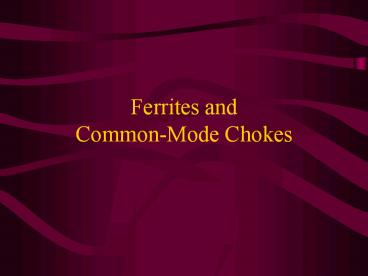Ferrites and Common-Mode Chokes - PowerPoint PPT Presentation
1 / 27
Title:
Ferrites and Common-Mode Chokes
Description:
Ferrites and Common-Mode Chokes Magnetic field tend to concentrate in high- permeability( ) materials. The quantity of reluctance( ) R depends on The ... – PowerPoint PPT presentation
Number of Views:191
Avg rating:3.0/5.0
Title: Ferrites and Common-Mode Chokes
1
Ferrites and Common-Mode Chokes
2
- Magnetic field tend to concentrate in
high- permeability(???) materials.
e.g. The magnetic flux ? was confined to the
ferromagnetic core.
- Some of the flux leaks out and completes the
magnetic path through the surrounding air.
3
- The quantity of reluctance(??) R depends on
- The permeability ? of the
- magnetic path.
- Cross-sectional area A
- Length l
- ??? lumped circuits ??? magnetic circuits
- Voltage ? magnetomotive force
- (mmf) NI
- Current ? magnetic flux ?
4
- High-permeability core Rcore ltlt Rair
- the majority of the flux confined to the core.
5
- The reluctances of the path
- ? the permeablities of the path.
- The portion of the total flux that remains in the
core - ? the ratios of the relative permeablities of
the two paths.
6
- Common-mode Differential-mode current
Consider the pair of parallel conductors
carring current I1 and I2. Decompose with
differential-mode current ID and common-mode
current IC.
I1 IC ID I2 IC ? ID
ID 0.5 ( I1 ? I2) IC 0.5 ( I1 I2)
?
7
- The differential-mode currents
- are equal in magnitude but oppositely directed in
the two wires. - The common-mode currents
- are equal in magnitude and are directed in the
same direction.
8
- The differential-mode current are oppositely
directed. - ? The resulting electric field will also be
oppositely directed.
Two conductors are not collocated. ? The fields
will not exactly cancel. ? It will subtract to
give a small net radiated electric field.
9
- The common-mode currents are directed in the same
direction. - Their radiated fields will add giving a much
larger contribution to the total radiated field
than will the differential-mode current.
10
- A pair of wires carrying currents I1 and I2 are
wound around a ferromagnetic core.
- Calculate the impedance
11
Consider common-mode currents (I1IC, I2IC) ?
ZCM p (L M)
12
Consider differential-mode currents (I1ID and
I2ID) ? ZDM p (L ? M)
If the windings are symmetric and all the flux
remains in the core ? LM ZDM 0
13
- In the ideal case (LM)
- A common-mode choke
- has no effect on differential-mode current.
- but selectively places an inductance 2L in series
with the two conductors to common-mode currents. - Thus, common-mode choke can be effective in
blocking common-mode currents.
14
- Ferromagnetic materials
- ''saturation effect'' at high currents
- Their permeabilities tend to deteriorate with
increasing frequency. - The functional or differential-mode current ID
are the desired currents and usually large in
magnitude. - The common-mode choke
- Fluxes (due to high differential-mode currents)
cancel in the core. - No saturation.
15
Ferrite core materials have different frequency
responses of their permeability.
Typically MnZn, NiZn
16
- The impedance for a typical MnZn core
17
- The impedance for a typical NiZn core
18
- The frequency response of the impedance of
- a inductor (formed by winding five turns of 20
gauge wire on two toroids)
1 MHz 60 MHz MnZn 500? MnZn 380 ? NiZn 80
? NiZn 1200 ?
19
6.8 Ferrite Beads
20
- Ferrite materials are basically
- nonconductive ceramic(??) materials
- Ferrite materials can be used to
- provide selective attenuation(??) of
high-frequency signals and not affect the more
important lower-frequency components of the
functional signal.
21
- The most common form of ferrite materials is a
bead.
- The ferrite material is formed around a wire, so
that - the device resembles an ordinary resister.
22
- The ferrite bead can be inserted in series with a
wire or land, and provide a high-frequency
impedance in that conductor. - The ferrite bead affects both differential- mode
and common-mode currents equally. - If the high-frequency components of the
differential-mode current are important from a
functional standpoint, then the ferrite bead may
affect functional performance of the system.
23
- The current produces
- magnetic flux in the
- circumferential direction.
- This flux passes through the bead material
- producing an internal inductance.
- The inductance
- ? the permeability of the bead material
- Lbead ?0?rK
- K const, dep. on the bead dimension
24
- The bead material is characteristized by
- a complex relative permeability
- ?r ?'r(f) ? j ?"r(f)
- The real part ?'r
- is related to the stored magnetic energy in the
bead material. - The imaginary part ?"r
- is related to the losses in the bead material.
- ?'r ?"r both are functions of frequency.
25
- From this result,
- the equivalent circuit consists of
- a resistance (dep. on frequency) in series with
an inductance (dep. on frequency)
26
- Typical ferrite beads give impedances of order
100? above 100MHz. - Multiple-hole ferrite beads can be used to
increase the high-frequency impedance.
- The impedance of ferrite beads is typically used
in low-impedance circuits. - Ferrite beads and the other uses of ferrites are
susceptible to saturation when used in circuits
that pass high-level, low-frequency currents.
27
END































